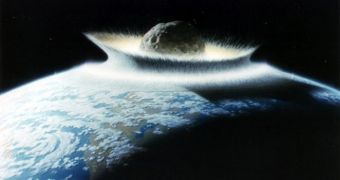According to a panel of investigators from the American space agency, NASA should focus more on devising planetary defense strategies. The Ad-Hoc Task Force on Planetary Defense, a division of the NASA Advisory Council, explains that safeguarding Earth from the effects of impacts with large space rocks should be the main priority of most – if not all – space agencies worldwide. The new report shows that the creation of a Planetary Defense Coordination Office would be a large step in the right direction. International collaboration in the field is also indicated, Space reports.
The task force that is now releasing its recommendations met between July -9 in Boulder, Colorado. Its seven members looked at existing and planned methods of detecting, intercepting, deflecting and destroying incoming space rocks, and then determined that a more unified, thorough approach is needed. One of the primary things the group considered essential for our planet's safety is the construction and launch of a sensitive infrared observatory, which should be placed in a Venus-like orbit.
This type of spacecraft would allow for a more accurate and early detection of dangerous near-Earth objects (NEO), which may be lurking in the inner solar system. The panel explains that the time of protecting our planet by conducting ground-based observations alone has passed, and that space-based studies are now required as well.
“At the end of our process, our recommendations will go to the NASA Administrator and for the first time will address the overall issue of protecting the planet from asteroid impacts. Those recommendations will include not only finding NEO that potentially pose a threat, but pro-active prevention of impacts […] and working with the international community in order to be prepared to take that kind of action,” explains former astronaut Russell Schweickart.
The new conclusions represent “the first time NASA will have that kind of serious, internal set of recommendations,” he adds. The spaceflight expert was the co-chair of the Ad-Hoc Task Force, together with former NASA astronaut Tom Jones. “It really is a turning point. For decades we were bumping along, barely aware that there were near-Earth objects. When NASA got involved in the mid-1990s... there's been a dramatic increase in the discovery rate. It was sort of an 'ah-ha' moment for the community in terms of science,” says Don Yeomans. He is the manager of the NASA NEO Program Office, which is based in Pasadena, California, at the Jet Propulstion Laboratory (JPL).

 14 DAY TRIAL //
14 DAY TRIAL //